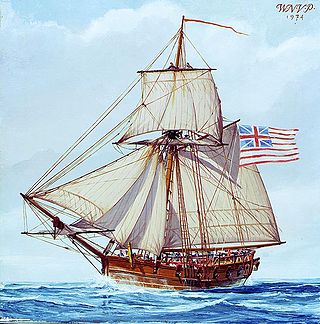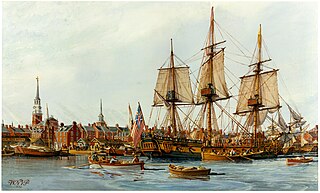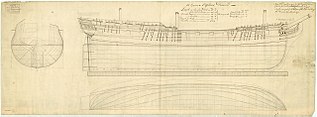
HMS St John was a Royal Navy 6 gun schooner [1] attacked by American colonists in Newport, Rhode Island in 1764.

HMS St John was a Royal Navy 6 gun schooner [1] attacked by American colonists in Newport, Rhode Island in 1764.
Rhode Islanders were violently opposed to the passage of the Sugar Act in 1764, because the colony's main industry was producing rum from molasses. To collect the tax, the British sent several ships to New England, including HMS Squirrel.
In 1764, crew members on another British ship, HMS St John, had allegedly stolen goods from Newport merchants. Therefore, a group of Rhode Islanders took control of Fort George on Goat Island in Newport harbor and fired cannon shots at the British ship. The shots were one of the first open acts of rebellion against the British government in America.
The Rhode Islanders were acting under orders from local officials, but they dispersed before HMS Squirrel, a twenty-gun ship, arrived at the scene. St John successfully fled the harbor and played a part in moving gunpowder away from Nassau on 4 March 1776 following the amphibious raid on Fort Montagu. [2]

USS Providence was a sloop-of-war in the Continental Navy, originally chartered by the Rhode Island General Assembly as Katy. The ship took part in a number of campaigns during the first half of the American Revolutionary War before being destroyed by her own crew in 1779 to prevent her falling into the hands of the British after the failed Penobscot Expedition.

Alfred was the merchant vessel Black Prince, named for Edward, the Black Prince, and launched in 1774. The Continental Navy of what would become the United States Navy acquired her in 1775, renamed her Alfred after 9th century English monarch Alfred the Great, and commissioned her as a warship. She participated in two major actions, the battle of Nassau, and the action of 6 April 1776. The Royal Navy captured her in 1778, took her into service as HMS Alfred, and sold her in 1782. She then became the merchantman Alfred, and sailed between London and Jamaica.

The Gaspee affair was a significant event in the lead-up to the American Revolution. HMS Gaspee was a Royal Navy customs schooner that enforced the Navigation Acts around Newport, Rhode Island, in 1772. It ran aground in shallow water while chasing the packet boat Hannah on June 9 near Gaspee Point in Warwick, Rhode Island. A group of men led by Abraham Whipple and John Brown I attacked, boarded, and burned the Gaspee to the waterline.

HMS Rose was a 20-gun (Seaford-class) sixth-rate post ship of the Royal Navy, built at Blaydes Yard in Hull, England in 1757. Her activities in suppressing smuggling in the colony of Rhode Island provoked the formation of what became the Continental Navy, precursor of the modern United States Navy. She was based at the North American station in the West Indies and then used in the American Revolutionary War. She was scuttled in the harbour of Savannah, Georgia in 1779. A replica was built in 1970, then modified to match HMS Surprise, and used in two films, Master and Commander: Far Side of the World and Pirates of the Caribbean: On Stranger Tides.

Goat Island is a small island in Narragansett Bay and is part of the city of Newport, Rhode Island, U.S. The island is connected to the Easton's Point neighborhood via a causeway bridge. It is home to the Newport Harbor Light (1842), residences, a restaurant, event space, and hotel. It was also home to several military forts and to the U.S. Naval Torpedo Station, and was the site of the attacks on HMS St John and HMS Liberty.

HMS Orpheus was a British Modified Lowestoffe-class fifth-rate frigate, ordered on 25 December 1770, as one of five fifth-rate frigates of 32 guns each contained in the emergency frigate-building programme inaugurated when the likelihood of war with Spain arose over the ownership of the Falkland Islands. Sir Thomas Slade's design for Lowestoffe was approved, but was revised to produce a more rounded midships section; the amended design was approved on 3 January 1771 by Edward Hawke's outgoing Admiralty Board, just before it was replaced. The contract to build the Orpheus was awarded to John Barnard at Harwich, the keel being laid in May 1771, and the frigate was launched 7 May 1773, at a cost of £12,654.16.11d. She sailed from Harwich on 24 May for Sheerness Dockyard, where she was completed and fitted out to the Navy Board's needs by 11 June.

HMS Lively was a 20-gun post ship of the Royal Navy, launched in 1756. During the Seven Years' War she captured several vessels, most notably the French corvette Valeur in 1760. She then served during the American Revolutionary War, where she helped initiate the Battle of Bunker Hill. The French captured her in 1778, but the British recaptured her in 1781. She was sold in 1784.

HMS Asia was a 64-gun third-rate ship of the line of the Royal Navy, built by Thomas Bucknall and launched on 3 March 1764 at Portsmouth Dockyard. She participated in the American Revolutionary War and the capture of Martinique in 1794. She was broken up in 1804.
HMS Diana was the first British vessel that colonial forces captured and destroyed during the American Revolutionary War.
USS Spitfire was a row galley authorized and constructed by Rhode Island during the American Revolution, and was placed in service in 1776 in the Rhode Island Navy. During this age of sail, row galleys were highly maneuverable compared to sailing ships whose movements were dependent on the wind. Spitfire had a reportedly successful career, helping to capture British cargo ships and engaging in the fight against British warships.
HMS Preston was a 50-gun fourth rate ship of the line of the Royal Navy, built at Deptford Dockyard by Adam Hayes to the draught specified in the 1745 Establishment, and launched on 7 February 1757.
HMS Boyne was a 70-gun third rate ship of the line of the Royal Navy, built at Plymouth Dockyard to the draught specified in the 1745 Establishment as amended in 1754, and launched on 31 May 1766. She was first commissioned for the Falkland Crisis of 1770 after which, in 1774, she sailed for North America. From March 1776, she served in the English Channel then, in May 1778, she was sent to the West Indies where she took part in the battles of St Lucia, Grenada and Martinique. In November 1780, Boyne returned home, where she was fitted for ordinary at Plymouth. In May 1783, she was broken up.

HMS Halifax was a schooner built for merchant service at Halifax, Nova Scotia in 1765 that the British Royal Navy purchased in 1768 for coastal patrol in North America in the years just prior to the American Revolution. She is one of the best documented schooners from early North America.
Liberty was a sloop owned by John Hancock, an American merchant, whose seizure was the subject of the Liberty Affair. Seized by customs officials in Boston in 1768, it was commissioned into the Royal Navy as HMS Liberty, and she was burned the next year by American colonists in Newport, Rhode Island in one of the first acts of open defiance against the British crown by American colonists.
HMS Squirrel was a Royal Navy sixth rate post ship, built in 1755. She served during the French and Indian War, most notably at Louisbourg and Quebec, and the American Revolution, during which she captured two French privateers. The Royal Navy sold her in 1783. J. Montgomery purchased her and she became the Greenland whaler Union. Then in 1790–91 she became a slaver, making five slave-trading voyages. Between 1796 and 1802 she made two voyages for the British East India Company (EIC). She then traded between London and Liverpool. She was last listed in 1804.
Fort Wolcott was a fortification on the small Goat Island in Newport Harbor of Narragansett Bay less than 1 mile west of the city of Newport, Rhode Island. The attacks on HMS St John and HMS Liberty occurred near the fort.
HMS Canceaux was a sloop active in both the hydrographic exploration of the Atlantic Canada and New England coastline and in the American Revolutionary War. She played an integral role in the battle for control of Maine, in particular at the Burning of Falmouth. She began her life as a merchant vessel and would eventually be transformed to a military vessel for the Royal Navy, equipped to command the razing of major settlements. After leaving the Saint Lawrence River estuary in 1771, Canceaux actively shaped the maritime history of the American Revolution.

HMS Kingfisher was the second ship in the 14-gun Swan class of ship sloops, to which design 25 vessels were built in the 1760s and 1770s. She was launched on 13 July 1770 at Chatham Dockyard, and completed there on 21 November 1770. She took part in the American Revolutionary War, enforcing the blockade of the Delaware Bay, and served in the Battle of Turtle Gut Inlet, near Cape May, New Jersey. While under the temporary command of Lieutenant Hugh Christian, she was burnt by her own crew to avoid capture on 7 August 1778 in Narragansett Bay during the Battle of Rhode Island.

HMS Tamar or Tamer was a 16-gun Favourite-class sloop-of-war of the Royal Navy.

HMS Fowey was a sixth-rate warship of the Royal Navy. Built in 1749, the ship was sunk in action with the French during the Siege of Yorktown in 1781. Mark Robinson was appointed to the Fowey, a 6th Rate of 24 guns, on the 13th June 1767, at Sheerness, and sailed via Spithead, to Plymouth, and thence to Madeira in September, and on to the East Coast of the American colonies, arriving at Charleston in 28 October 1767, relieving the Sardoine. “Pennsylvania Gazetter December 1767 Nov. 6. Captain Mark Robinson, of his Majesty ship Fowey, of 28 guns, who arrived here last week from Great Britain, is commanding officer, or Commodore of all his Majesty’s ships from Virginia to Cape Florida, including the Bahama Islands. Commodore Hood, stationed at Halifax, commands as far south as New York, and, it is said, a third Commodore will be stationed at Virginia.” The itinerary of the Fowey, with Mark Robinson in command was Charleston in 1768, Rebellion Roads, Charleston, Sandy Hook, Louisburg (October 1768, Halifax, Charleston Cape Fear Charleston, Fort Royal, Charleston, Halifax, Charleston, leaving the Fowey on the 31st January 1771. Mark Robinson believed that the small coasting vessels engaged in a great deal of smuggling, and he asked the Admiralty to buy a tender to examine creeks and islets. He was put straight by the Merchants of South Carolina on the matter of intra-colony trade, after the Sardoine and Captain Hawker affair, and was asked not to stop interior trade. He seems to have heeded that advice, as there is no record that he seized any coasting vessels while he was in South Carolina. On the 29th April 1770 Sir William Draper embarked in the Fowey, to visit Governor Tryon at the Cape Fear. Mark Robinson on the Fowey is also stated as having arrived in Charles Town 8 October 1770, from Virginia and sailed for Virginia again on the 29 January 1771. Whilst he was on this coast he had the satisfaction of preserving Charleston from the effects of an alarming conflagration, a service for which the Merchants of South Carolina expressed their gratitude by a public vote of thanks, dated the 14th January 1771. He sailed from Charleston on the 22 January 1771. Her Captain on 1 January 1775 is listed as Cpt. Geo Montagu. The ship is noted as having received Lord Dunmore, the governor of the Colony of Virginia, when he fled the colony for safety after the Gunpowder Incident during the beginning of the American Revolution, marking the last departure of a Royal Governor from the colony, effectively ending British rule in Virginia. The National Park Service has identified it as a probable candidate for a wreck located off Yorktown, Virginia, in the York River.